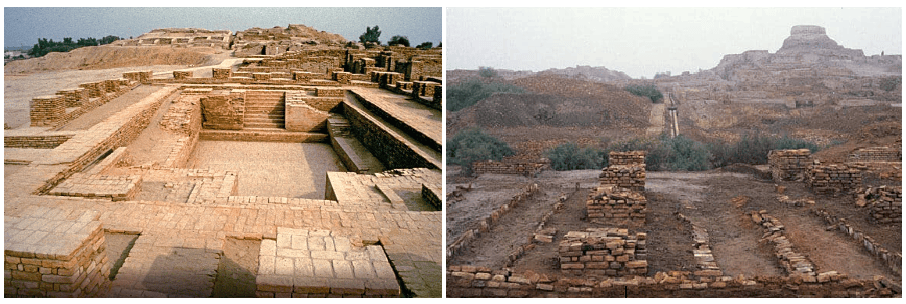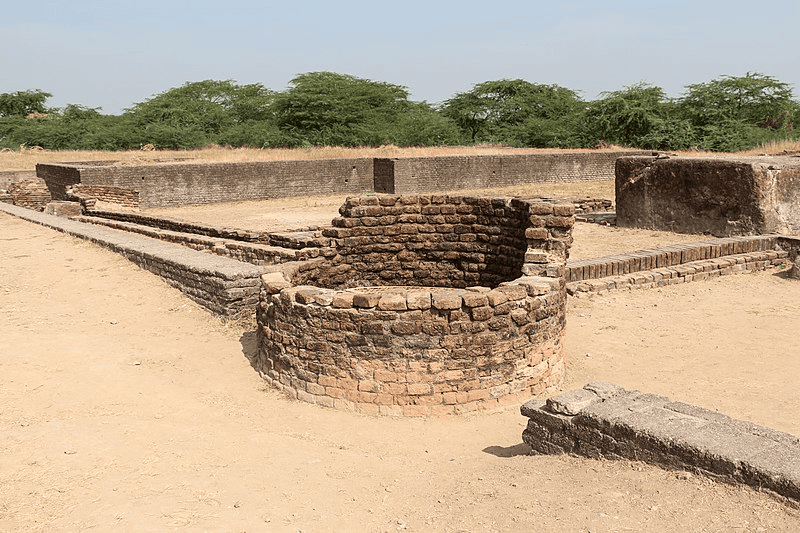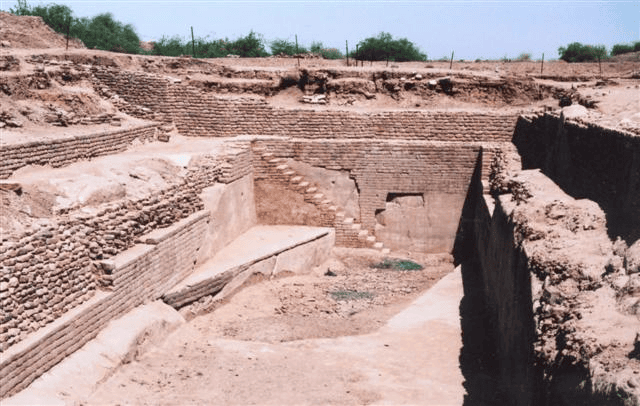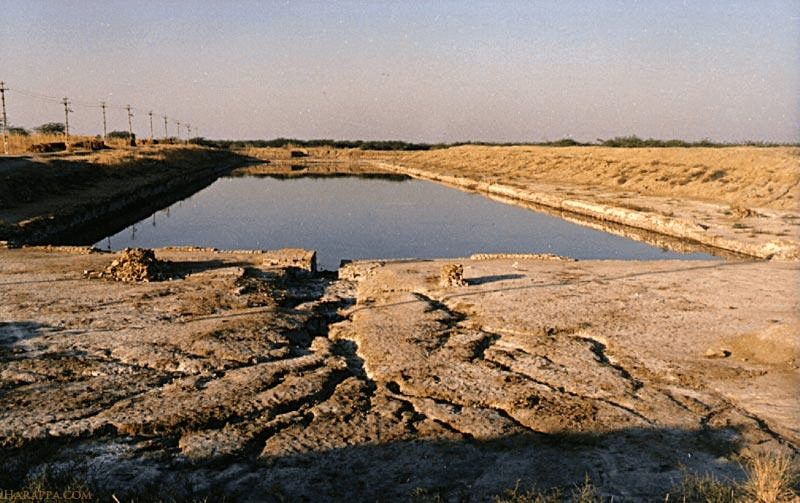Indus Valley Civilization: Architecture | History Optional for UPSC PDF Download
Indus Valley Civilisation Architecture
- While art forms like pottery and sculpture evolved during prehistoric times, the foundation of modern architecture can be traced back to the Indus Valley Civilization, particularly in the realm of town planning. This civilization, also known as the Harappan Civilization, thrived from 2600 BCE to 1900 BCE and witnessed the emergence of some of India's earliest large-scale buildings.
- A prosperous society developed along the banks of the Indus River in the latter half of the third millennium BCE, expanding across vast regions of North-Western and Western India. This era is recognized as the Harappan Civilization or Indus Valley Civilization (IVC).
- Various significant sites within the Indus Valley Civilization, each with its unique architectural characteristics along with similarities, showcased advanced urban architecture. Harappa and Mohenjo-daro, the two major sites of this civilization, stand out as some of the earliest and finest examples of urban planning.
- However, the urban nature of the Harappan civilization does not imply that all or most of its settlements were urban. In fact, a majority were villages. The Harappan sites exhibited a wide range in size and function, from large cities to small pastoral camps.
- The largest settlements included Mohenjodaro, Harappa, Ganweriwala, Rakhigarhi, and Dholavira. The second tier of Harappan settlements consisted of moderate-sized sites ranging from 10 to 50 hectares, such as Kalibangan. Smaller sites, ranging from 5 to 10 hectares, included Amri, Lothal, Chanhudaro, and Rojdi. Many settlements less than 5 hectares included Allahdino, Kot Diji, Rupar, Balakot, Surkotada, Nausharo, and Ghazi Shah.
Some distinctive features of Harappan urban architecture include:
- City Division:Most sites were divided into two parts:
- Citadel: A smaller, elevated area (about 40 to 50 feet higher) located on the western side of the town.
- Lower Town: A larger, lower-lying area on the eastern side, divided into wards like a chessboard.
- City Layout: Cities were laid out in a regular grid pattern, with roads running north-south and east-west at right angles.
- Construction Materials: Burnt bricks of standard dimensions (4x2x1 inches) were widely used, with a notable absence of stone buildings. These bricks were often coated with plaster and made waterproof with natural tar or gypsum.
- Drainage System: Underground drainage with inspection holes was a striking feature. Small drains from each house connected to main drains along the roads, emphasizing hygiene. Cesspits were placed at regular intervals.
- City Walls: Cities were surrounded by massive walls and gateways, possibly for controlling trade, military invasion, and flood prevention. Sections of the city included public buildings, houses, markets, and craft workshops.
- Street Layout: Streets and houses were organized in a grid pattern, although some deviations existed. Covered drains along the roads were common, and the alignment of streets and houses demonstrated conscious town planning.
The Harappan civilization, with its impressive urban architecture and advanced planning, laid the groundwork for later architectural developments in India.
Citadel
The Citadel of the Harappan cities comprised various buildings like the Great Bath, pillared assembly halls, granaries, etc.
Great Bath
- The Great Bath, discovered at Mohenjodaro, featured a sophisticated hydraulic system. It indicates the significance of public baths and ritualistic cleansing during that period.
- The pool was situated at the center of a large open quadrangle, surrounded by rooms on all sides. It was connected to these rooms by flights of steps at either end.
- Water Supply and Drainage: The pool was supplied with water from a nearby well, and the dirty water was drained into the city’s sewage system through a large corbelled drain.
Granaries
- The granaries in Harappan cities were designed with strategic air ducts and raised platforms, showcasing the intelligence behind their construction.
- The largest building in Mohenjodaro was a granary, and some sites like Harappa had as many as six granaries. This indicates the importance of grain storage in these cities.
- Granary of Mohenjodaro: The granary discovered in the citadel mound of Mohenjodaro consists of twenty-seven blocks of brickwork crisscrossed by ventilation channels. Below the granary were brick loading bays from which grains were raised into the citadel for storage. Although some scholars have debated its identification as a granary, its large size indicates it had some significant function.
- Great Granary of Harappa: This granary consisted of two rows of six granaries on raised brick platforms. South of the granary were rows of circular brick platforms used for threshing grains, as indicated by the presence of wheat and barley chaffs found in the crevices of the floors.
Pillared Assembly Hall
- The pillared assembly hall with twenty pillars arranged in rows of five likely supported a large roof.
- It might have served as the court of the city magistrate or as a secretariat of the State.
Housing Pattern
- People resided in houses of varying sizes, primarily consisting of rooms arranged around a central courtyard.
- The average citizen likely lived in blocks of houses in the lower city, with variations in house sizes. Some houses were single-room tenements, possibly for slaves, while others had up to twelve rooms.
- Bigger houses typically featured a square courtyard surrounded by several rooms, with passages leading to inner rooms. Frequent evidence of renovation activity was observed in these houses.
- Private Amenities: Larger houses or groups of houses had separate private wells, bathing areas, and toilets. Bathing platforms with drains were often located in rooms adjacent to wells. The bathing area floors were made of tightly fitted bricks, usually set on edge to create a watertight surface.
- The waste from toilets was sometimes discharged through sloping channels into jars or drains in the street outside.
- Small Houses: Small houses attached to larger ones might have been quarters for service groups working for affluent city dwellers.
- Entrance and Layout: Doorways and windows typically faced side lanes, rarely opening onto main streets. House entrances were through narrow lanes intersecting the streets at right angles. The view into the courtyard from the lane was blocked off by a wall.
Kitchen
- Houses typically had both indoor and outdoor kitchens. The outdoor kitchen was used in warmer weather to avoid overheating the house, while the indoor kitchen was utilized during colder periods.
- Present-day village houses in the region, such as those in Kachchh, still feature two kitchens, similar to the Harappan practice.
Staircases
- Remains of staircases suggest access to roofs or second stories.
- The presence of two or more story houses at Mohenjodaro is indicated by the thickness of the walls.
Floors
- Floors were generally made of hard-packed earth, often re-plastered or covered with sand.
Ceilings
- Ceilings were likely over 3 meters high, with roofs made of wooden beams covered with reeds and packed clay.
Doors and Windows
- Doors and windows were constructed from wood and mats. Clay models of houses depict doors that were sometimes carved or painted with simple designs.
- Windows had shutters, possibly made of wood or reeds and matting, with latticework grills above and below to allow light and air. Carved alabaster and marble latticework pieces found at Harappa and Mohenjodaro might have been set into the brickwork.
Toilets
- Toilets were present in many houses, ranging from simple holes in the ground above cesspits to more elaborate arrangements.
- Excavations at Harappa revealed toilets in almost every house. Commode toilets were made of large pots sunk into the floor, often associated with small jars for washing up.
- Toilet waste was sometimes discharged through channels into jars or drains in the street outside. Some individuals must have been responsible for regularly cleaning the toilets and drains.
Raw Material Used
- In villages, houses were primarily built from mud-brick, with mud and reeds used additionally. Stone was occasionally employed for foundations or drains.
- In towns and cities, buildings were constructed from sun-dried and burnt bricks. Baked bricks were used in Harappa and Mohenjodaro, while mud bricks were utilized in Kalibangan.
- In rocky areas like Kutch and Saurashtra, stone was extensively used. The fortification walls at Dholavira and remains of stone pillars in the citadel are distinctive features not found at other Harappan sites.
- Some house walls at Mohenjodaro survive up to a height of 5 meters, showcasing the strength of the bricks and the brick-laying skill of the Harappans.
- The ‘English bond style’ of brick laying, involving a sequence of long side (stretcher) and short side (header) arrangements, provided maximum load-bearing strength.
- The average size of bricks used in Harappan structures was uniform, with ratios of thickness, width, and length (1:2:4). This standardization indicates organized large-scale brick making, as individual house owners did not make their own bricks.

Water Management System
Drainage System
- Harappan settlements are known for their efficient and well-planned drainage systems.
- Even smaller towns and villages had impressive drainage systems.
- Drains for collecting rainwater were separate from sewage chutes and pipes.
- Drains and water chutes from the second storey were often built inside the wall, with an exit opening just above the street drain.
- At Harappa and Mohenjodaro, terracotta drain pipes directed wastewater into open street drains made of baked bricks.
- These street drains connected to large drains along the main streets, which emptied their contents into fields outside the city wall.
- The main drains were covered by corbelled arches made of brick or stone slabs.
- Rectangular soak pits for collecting solid waste were placed at regular intervals to prevent choking and health hazards.
- The well-maintained drainage system indicates the presence of civic administration responsible for sanitary requirements.
Washroom Drainage System at Lothal
In Lothal, the washroom drainage system encompassed:
- Efficient drainage of waste water from washrooms to maintain hygiene.
- Use of terracotta pipes for effective waste water disposal.
- Integration of the drainage system with the overall sanitation infrastructure of the settlement.
The Harappans made elaborate arrangements for water for drinking and bathing. The emphasis on providing water for bathing, evident at several sites, suggests that they were very particular about personal hygiene. It is possible that frequent bathing also had a religious or ritualistic aspect. The sources of water were rivers, wells, and reservoirs or cisterns.
The Great Bath at Mohenjodaro
- The Great Bath at Mohenjodaro is a remarkable example of the Harappan emphasis on bathing and hygiene.
- This brick-built structure measures 12 m. x 7 m. and is about 3 m. deep, with flights of steps at either end for access.
- The bed of the bath was made watertight using bitumen, and water was supplied by a large well in an adjacent room.
- A corbelled drain was also present for discharging water.
- The bath was surrounded by porticoes and sets of rooms, and scholars believe it was used for ritual bathing by kings or priests.
Wells and Water Sources
- Mohenjodaro is renowned for having a large number of wells, with estimates suggesting there may have been over 700 wells in the city.
- Most houses or house blocks had at least one private well, and many neighborhoods had public wells along the main street.
- Harappa had fewer wells compared to Mohenjodaro, but a depression in the city center may indicate a tank or reservoir that served the inhabitants.
- Dholavira, while having a few wells, is more famous for its impressive water reservoirs lined with stone.
- The city had water-storing tanks and step wells, showcasing advanced water management techniques.


Other Water Management Features
Allahdino (Near Karachi)
- Wells had a very small diameter to increase hydraulic pressure and raise groundwater levels.
- Groundwater may have been used to irrigate nearby fields.
Dholavira
- Dholavira had an impressive and unique water harvesting and management system, which was crucial in a region prone to frequent droughts.
- Rainwater from the catchment areas of two seasonal streams—Manhar and Mansar—was dammed and diverted to large reservoirs within the city walls.
- Several large, deep water cisterns and reservoirs were found, preserving precious stores of rainwater.
- There were 16 water reservoirs within the city walls, covering about 36 percent of the walled area.
- These reservoirs were protected by brick masonry walls, with some made by cutting into the bedrock.
Lothal Dockyard
- The dockyard at Lothal is a distinctive feature of the site.
- It is a trapezoidal basin enclosed by walls of burnt bricks.
- The dockyard had systems for maintaining a regular water level, including a sluice gate and a spill channel.


Many scholars argue that the Mesopotamian people of the Tigris-Euphrates Valley called Indus Valley civilisation as ‘Meluha’. Many Indus Valley seals have been found in Mesopotamia.
Key Sites of the Indus Valley Civilization and Their Archaeological Discoveries
Harappa (Present-day Pakistan, River Ravi)
- Coffin burial: Evidence of burial practices involving coffins.
- Granary: A granary found outside the fort, indicating storage of surplus grain.
- Phallus worship: Evidence of ritualistic worship of phallus symbols.
- Graveyard: Discovery of a graveyard, suggesting burial practices.
- Lingam and Yoni: Stone symbols representing the lingam and yoni, significant in Hindu worship.
- Mother Goddess: Artifacts depicting the Mother Goddess, indicating religious beliefs.
- Agricultural Tools: Wheat and barley found in wooden mortars, indicating agricultural practices.
- Dice and Mirrors: Discovery of dice, a copper scale, and a mirror, suggesting recreational and personal items.
Mohenjo-Daro (Present-day Pakistan, River Indus)
- Prepared Garments: Evidence of textile production and prepared garments.
- Temple-like Palace: Structure resembling a palace or temple, indicating administrative or religious significance.
- Pashupati Seal: Seal depicting Pashupati, a deity, suggesting religious practices.
- Dancing Girl Statue: Statue of a dancing girl, showcasing artistry and cultural practices.
- Ivory Weight Balance: Balance made of ivory, indicating trade and measurement practices.
- Citadel: Central elevated area for administrative or religious purposes.
- The Great Bath: Large bathing structure, possibly for ritualistic purposes.
- The Great Granary: Large granary, indicating storage and surplus of grains.
- Priest King Statue: Statue of a priest-king, indicating social hierarchy.
- Post-Cremation Burial: Burial practices following cremation.
Kalibangan
- Lower Fortified Town: Evidence of a lower fortified settlement.
- Fire Altar: Discovery of a fire altar, indicating ritualistic practices.
- Boustrophedon Style: Evidence of writing in boustrophedon style (alternating direction).
- Wooden Drainage: Wooden drainage systems, indicating advanced sanitation.
- Copper Ox: Discovery of a copper ox figurine.
- Earthquake Evidence: Signs of earthquake impact.
- Wooden Plough: Wooden plough used in agriculture.
- Camels Bone: Remains of a camel, indicating domestication.
Lothal (Gujarat)
- Port Town: Evidence of a port town, indicating maritime trade.
- Evidence of Rice: Findings related to rice cultivation.
- Fire Altar: Discovery of a fire altar.
- Graveyard: Evidence of burial practices.
- Ivory Weight Balance: Balance made of ivory.
- Copper Dog Figurine: Figurine of a dog made of copper.
- Painted Jar: Painted jar, modern-day chess pieces, terracotta figures of horse and ship, and instruments for measuring angles.
Rangpur (Gujarat)
- Evidence of Rice: Findings related to rice cultivation.
Surkotada
- Horse Bone: Discovery of horse bones.
- Stone Covered Grave: Stone-covered graves indicating burial practices.
Malavan
- Canals: Evidence of canal systems.
Chanhudaro (Present-day Pakistan)
- Bangle Factory: Evidence of a bangle manufacturing site.
- Ink Pot: Discovery of an ink pot.
- No Citadel: Unique as the only city without a citadel.
- Carts with Seated Driver: Findings of carts with figures of seated drivers.
Daimabad (Maharashtra)
- Bronze Sculptures: Discovery of bronze sculptures, including a bronze chariot and a bronze buffalo.
Amri (Pakistan)
- Rhinoceros Remains: Actual remains of rhinoceros found at the site.
Alamgirpur (Meerut, Uttar Pradesh)
- Impression of Cloth: Impression of cloth found on a trough.
- Broken Blade: Discovery of a broken blade made of copper and ceramic items.
Roparis (Punjab, India)
- First Harappan Site: Considered the first Harappan site of independent India.
- Buildings: Buildings made of stone and soil.
- Dog Burials: Evidence of dogs buried with humans.
- Inscribed Seal: Inscribed steatite seal with typical Indus pictographs.
- Pit Burials: Discovery of oval pit burials.
Banawali (Haryana)
- Settlement Shape: Oval-shaped settlement.
- Radial Streets: Unique for having radial streets.
- Toy Plough: Toy plough found at the site.
- Barley Grains: Largest number of barley grains discovered here.
Dholavira (Gujarat)
- Site Division: Unique for being divided into three parts.
- Water Reservoir: Giant water reservoir discovered.
- Water System: Unique water harnessing system with dams and embankments.
- Stadium: Discovery of a stadium.
- Inscription: Inscription comprising 10 large-sized signs, resembling an advertisement board.
Rakhigarhi (Haryana)
- Largest Site: Considered the largest site of the Indus Valley Civilization.
- Findings: Granary, cemetery, drains, and terracotta bricks discovered.
- Provincial Capital: Believed to be the provincial capital of the Harappan Civilization.
Mehrgarh (Pakistan)
- Precursor to Indus Valley Civilization: Considered a precursor to the Indus Valley Civilization.
- Findings: Pottery and copper tools discovered at the site.
Kot Diji (Pakistan)
- Excavations: Tar, statues of a bull and a mother goddess excavated from the site.
Suktagandor (Pakistan)
- Clay Bangles: Clay bangles found at the site, marking it as the westernmost site of the Indus Valley Civilization.
Balu (Haryana)
- Plant Remains: Various plant remains discovered, including the earliest evidence of garlic.
Kerala-no-dhoro (Gujarat)
- Salt Production: Site known for salt production during the Indus Valley Civilization.
Kot Bala (Pakistan)
- Furnace Evidence: Earliest evidence of a furnace found at the site.
Mand (Jammu and Kashmir)
- Northernmost Site: Considered the northernmost site of the Indus Valley Civilization.
Other Prominent Sites:
- Mehrgar (Pakistan)
- Desalpur (Gujarat)
- Pabumath (Gujarat)
- Shikarpur (Gujarat)
- Sanauli (Uttar Pradesh)
- Kunal (Haryana)
- Karanpura (Rajasthan)
- Ganeriwala (Punjab)
|
367 videos|995 docs
|
FAQs on Indus Valley Civilization: Architecture - History Optional for UPSC
| 1. What were the key water management features of the Indus Valley Civilization? |  |
| 2. How did the architecture of the Indus Valley Civilization reflect their society? |  |
| 3. What archaeological discoveries have been made at key sites of the Indus Valley Civilization? |  |
| 4. How did the geographical features of the Indus Valley influence its civilization? |  |
| 5. What role did the citadel play in the urban planning of the Indus Valley Civilization? |  |















